|
Stewart Phonographs and Beyond: W.H. Banfield & Sons
by Keith Wright
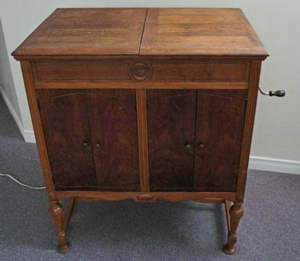
|
|
Symcophonic console with hardware labelled W.H. Banfield and Sons,
which started this research.
(Image courtesy Raquel Schubert)
|
|
|
What did we ever do without e-mail?
Well, besides all that.
I received the following e-mail in
March, 2014, from someone in Montreal:
"Hi Keith,
"I trust all is well. My husband just recently
purchased a phonograph from a neighbor that
only knew one thing about it: it belonged to their
mother [who] seems to have gotten it from her
mother, back in Toronto. That’s it.
"Now my husband is a musician and music
lover and for him, so long as it played, he was
happy! Which it does and the sound is just so
nostalgic. We are not collectors of any sort, nor
connoisseurs of antiques.
"That being said, there really isn’t much history
on this phonograph (Can’t find anything on the
Internet) and I was hoping that someone could
help us know more about it. Perhaps its history,
who made it, and even where it comes from.
"Could you help us with something like that?
If not, do you know someone that could?
"Thank you in advance."

|
|
Detail of letterhead from collection of Bill and Betty Pratt showing exaggerated Banfield factory and noting manufacture of
"phonograph motors". (Image courtesy Betty Pratt)
|
|
|
Attached pictures showed a typical console
gramophone labelled as a "Symcophonic".
Pictures in follow-up e-mails showed the back
of an "orthophonic" style soundbox which read:
"Alethophonic, Reg. True Tone 1927, W.H.
Banfield and Sons Ltd., Toronto, Canada".

|
|
Photograph showing factory more modest than letterhead above of
W.H. Banfield and Sons Ltd., "Manufacturers to the British and
United States Governments since December, 1914", 370 Pope Avenue
[obviously, should read "Pape"], Toronto. Established 1885.
(Image courtesy Canada’s Aid to the Allies and Peace Memorial, pg. 56)
|
|
|
"W.H. Banfield" sounded familiar, and it should
have. The first two hits, doing the obligatory
Google search for ‘Banfield phonograph’,
turned out to be what I should have already
remembered—Betty and Bill Pratt’s APN article
on portables "Portable Pastimes"
in Antique Phonograph News, Nov-Dec 2007 and my own
CAPP page on the Stewart Phonograph, both
linking the Banfield Company to that round,
metallic machine. Clearly Banfield had been
up to more phonographic activities than making
Stewarts.
According to the Canadian Orange Historical Site,
William Henry (commonly referred to as "W.H.")
Banfield was born in Quebec City July 7, 1843,
he served with #2 Company, Montreal Engineers
during the Fenian Raids and moved to Toronto in
1876.
Industries Canada (1888) said W.H. was born
in Quebec City in 1844. "While in Quebec he
occupied the position of foreman of the North
Shore Railway shops while under construction…
After he came to Toronto he was also the special
commissioner appointed by the Australian
Government to inspect the cars built under
contract by the Ontario Car Co., of London, Ont."
He began working in Toronto as a foreman die
maker for the Dominion Tin Works and started
his own business in 1883. "Here he has all the
latest improved machinery, including the new
rope transmission, and is prepared to promptly
fill all orders for the cutting of every description
of dies of the highest artistic excellence…and
those of his design and manufacture are in use all
over the Dominion and the United States…He
now has a large order for the famous Kirkwood
Grate Bar, and is placing them under the whole
of Gooderham & Worts Boilers…Mr. Banfield
has over $10,000 worth of contracts on hand at
present…"
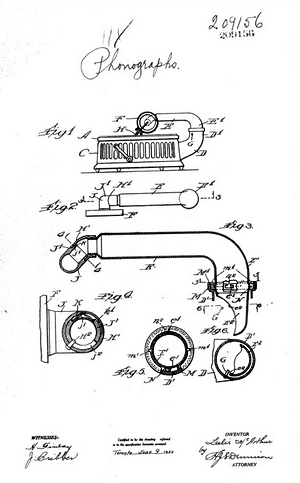
|
|
Drawing from Canadian patent CA209156 issued March 1, 1921,
showing Stewart design. Inventor is the same as the US patent, Leslie
McArthur, but the owner is Harry Sommerville Banfield.
(Courtesy Canadian Intellectual Property Office)
|
|
|
The premises grew over the years, with Industries
Canada (1888) marking the initial establishment
on Front Street East, and moving to 90 York,
"but the steady growth of this trade compelled
fresh enlargements, and Mr. Banfield has just
completed the erection of a new factory on
Wellington Street". Might’s City Directory of
1913 lists "120 Adelaide W. W.H. Banfield &
Sons, machinists., Banfield Edwin J. mfrs agt".
Then in 1918 and 1919 lists, "370-4 Pape Ave.
Banfield, Wm H & Sons" and finally in 1922
lists, "370-86 Pape Ave. Banfield Wm H & Sons,
machs" which is the address as shown in the
letterhead from the collection of Bill and Betty
Pratt.
In "Canada’s Aid to the Allies and Peace
Memorial", published in 1918, which focused
on what the various provinces, people, and
companies had done to help the Allied cause
during World War I, W.H. Banfield has a page
including a Roll of Honor. On that page, Banfield
is listed as "Manufacturers to the British and
United States Governments since December,
1914…Established 1885… Principal Lines of
Manufacture During Peace and Reconstruction
Times, Special Machinery, Sheet Metal
Stampings, Power Presses, Pressed Steel Parts,
Spun and Stamped Brass Goods, Electric Fixtures
Parts and Fittings".
Issues of "Motor Boating" between 1914 and
1919 have adverts for "McQuay-Norris Leak
Proof Piston Rings" ("No other piston ring
is made with the mechanical perfection…"),
"Canadian Factory, W.H. Banfield & Sons, Ltd.,
372 Pape Ave., Toronto." I have also discovered
an abbreviated advert for a "Canadian Highland
Broadsword" that in part states, "Maker: W.H.
Banfield & Sons, Toronto. Banfield was one of
only 2 or 3 sword makers known to have made
swords in Canada. His Company was primarily a
tool and die company and were tinsmiths as well.
They operated from 1877-1919."
Nothing phonographic so far. Now what is the
connection to Stewart?
According to the Mainspring Press Record
Collector’s Blog, "The Stewart Phonograph,
with its distinctive round metal case, caused a
brief flurry in the market when it was introduced
in 1916. It was manufactured by the Stewart
Phonograph Company of Chicago, an offshoot of
the Stewart-Warner Corporation, and was headed
by industrialist J. K. Stewart.

|
|
Toronto Daily Star, June 22, 1920, pg. 9.
|
|
|
"Stewart filed a trademark application on May
13, 1916, claiming use of the script trademark
on phonographs since February 15, 1916. The
machines were prominently advertised beginning
in the spring of that year, and a special pitch was
made to drug-store owners."
Being not much
larger than a 10" record, the Stewart must have
been very convenient for travel. One advert calls
it a "small Phonograph for campers, picknickers,
summer cottagers or anyone wishing a small,
light-weight Phonograph." I have no idea how I
missed this for my article on "Canoedling With
a Gramophone" in Antique Phonograph News, Jul-Aug 2013.
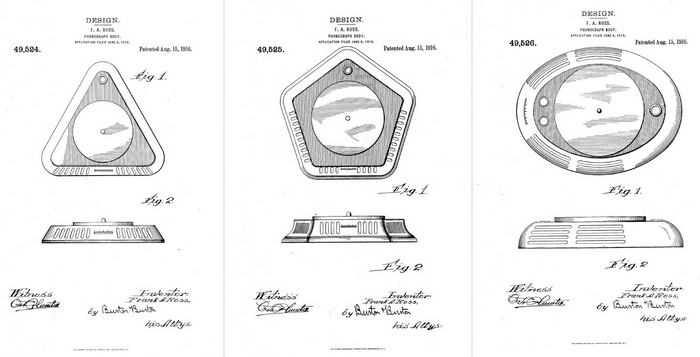
|
|
Can you imagine a Stewart looking like this? The circle was Stewart’s first design but before that patent was approved, they also applied for these 3 other designs.
(Courtesy US Patent Office and Trademark Office)
|
|
|
A search through the US patent database actually
shows Stewart trying out a few…novel designs
for phonograph-bodies (all disc machines),
applying for patents on June 8, 1916, which were
all approved on August 15, 1916. Patented were
phonographs shaped as triangles, pentagons and
ovals. The circular shape that we know as the
"Stewart Phonograph" was applied for earlier,
on January 5, 1916, but not approved until
September 5 of that year, by which time Stewart
had possibly hedged their bets by applying for
the other novel shapes. During their production
run, there were two designs for the reproducer/
tonearm assemblies: straight, shown early and a
second, a bent one shown later.

|
|
Eaton’s catalog 1926
|
|
|
We know that many of the plates on the Stewart
machines say "Improved Stewart Phonograph,
Stewart Phonograph Corporation Limited,
Toronto, Canada", so where is that connection?
As noted by Betty Pratt, a corporate file at the
Ontario Provincial Companies Branch indicates
there was a separate Canadian company
established in Ontario. The pamphlet included
with this shows a Toronto address, probably for
the showrooms at 1110 Temple Building, erected
in 1896 at Richmond and Bay Street, one of the
first large skyscrapers built for the Independent
Order of Foresters. There are ads for Stewart in
Eaton’s catalogues of 1919, 1920, and 1921.
Further noted by Betty, the 1920 Might’s City
Directory shows Stewart Phonographs as
distributors, on Pape Ave. Theodore Vatcher was
manager in 1922, and Earl M. Jones, manager
in 1923. "During these years the firm used
the premises of W. H. Banfield & Sons Ltd.,
manufacturers of lighting fixtures and phonograph
motors, 370-386 Pape Ave." (Letter from Toronto
City Clerk answering George Wonch, Aug. 30,
1966; courtesy Horst Weggler). The Globe,
Sept. 1, 1920, p. 11 stated that Banfield purchased
an entire plant from the U.S. and moved it to
Toronto.
I found in the Might’s Toronto Directory of
1921 a listing of, "STEWART PHONOGRAPH
CORPoration, Carl Reimers Manager,
Distributors of The Improved Stewart
Phonographs, 8 Colborne" (currently the site of
the Cosmopolitan Hotel).

|
|
Toronto-branded Stewart in the collection of Domenic DiBernardo.
(Image courtesy Cheryl Wright)
|
|
|
A search through the Canadian patent database
shows CA 209156, issued 1921-03-01, which has
identical drawings to the Stewart USD 1,249,791
patent. This Canadian patent shows the same
inventor as the US one (Leslie McArthur) but is
owned by none other than Harry Sommerville
Banfield, one of W.H.’s sons, who was the
Secretary-Treasurer of the company. The
Banfields had moved in the nick of time as the
US Stewart Phonograph went under shortly
thereafter. There is an article in "Presto" dated
December, 1922, that states, "John W. Kingsbury,
Binghampton, N.Y., has purchased, subject to
liens, the assets of the Stewart Phonograph Co.,
according to the announcement of William H.
Riley trustee." The article goes on to say that
an attorney representing W.H. Mansfield [sic]
objected to the sale of patents held by the Stewart
Phonograph Co., claiming the Canadian firm was
owner of the patents. The trustee said he was
selling only the tangible holdings. So, Stewart
Phonograph after this point is owned by and is
solely produced by W.H. Banfield & Sons of
Toronto, Canada. (What’s the constant joke about
reporters getting names right?)
The chicken-and-egg question remained, for me,
as to whether Banfield started into phonograph
parts before making Stewarts or started with an
order for Stewarts. My most recent find was from
The Globe, November 29, 1919, where page 23
is devoted to "phonographs", pianos and music
in general. In an article titled "World Market
is Entered by Canadian Firm" it is reported that
W.H. Banfield & Sons, "finding themselves
possess of a big munitions plant" is now "working
at top speed on
phonograph
motors and
phonographs."
Also in Canadian
Machinery and Metalworking, Jan-
Jun 1921, there
is a Banfield
advert (listing
the address 370-
386 Pape) that
states, "Have
You Need for
a Factory to
Make Special
Machinery for
You? We make
exceptionally
high-grade
phonograph
motor [sic]
requiring skillful
workman,
working to close
limits. They
are considered
standard in the
Phonograph Trade. We can manufacture complete
or parts for anything you may need."
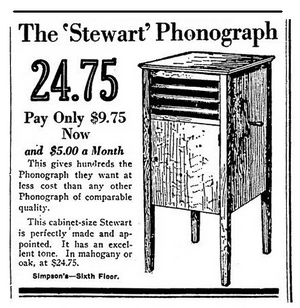
|
|
An attempt to grow the Stewart brand away from the round phonograph?
Toronto Daily Star, April 2, 1923, pg. 15.
|
|
|
An advert
for Hughes Music and Sales, in the Toronto Star
in 1922 mentions, "Large Double-Spring Banfield
Motor" and "Large Parlor Size [talking machine],
Brand New, Plays all Records, Genuine Banfield
Motor." If they started with Stewarts, they had or
were branching out.
Banfield may have also tried to grow the Stewart
brand out of the round metal machines as, a
Simpson’s advert from 1923 lists "The ‘Stewart’
Phonograph" showing a "cabinet-size Stewart".
The Toronto Daily Star has 33 references to
Stewart Phonographs from Oct. 3, 1919 to Apr. 2,
1923.
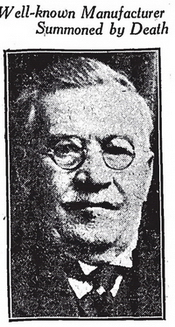
|
|
The only picture of old W.H. the author
could find, accompanied his obituary.
The Globe and Mail, December 8, 1925,
page 9.
|
|
|
Old W.H. passed away December 7, 1925 but the
company continued to thrive.
Fortunately for them, Banfield was not limited
to the Stewart Phonograph or even phonographs
in general. An advert in the Canadian Jewish
Review, Sept. 14, 1928 shows the main Pape
address in Toronto, 4 branch offices (Montreal,
Winnipeg, Vancouver and Calgary) as well as
a plethora of electrical fittings, stampings, dies,
tools and goods along with phonograph motors,
tonearm and reproducers.
So far, I have been able to determine that
Banfield marketed one of their own non-Stewart
machines but their parts did end up in at least
three others. As noted in the original e-mail
that started this research, Banfield made parts
labelled "Alethophonic" which ended up in
"Symcophonic" gramophones. I have seen
pictures of one portable machine that was very
similar to a Victor VV-50 portable with a plate
which reads, "’Companion’ made in Canada,
W.H. Banfield & Sons Limited, Toronto.
Canada". The Musée des ondes Emile Berliner
in Montreal displays a portable they label
"Alethophonic", presumably based on its Banfield
parts. Moogk does make reference to a portable
gramophone built and sold by Banfield billed as,
"A High-Grade Portable Phonograph with Tone
Quality and Volume equal to most full cabinet
instruments." I have also documented a number
of uprights for sale in Tweed and Barrie, Ontario,
and in Bromhead, Saskatchewan, labelled
"Golden Throated International" that have
Banfield parts. One example has to be carefully
compared against a Victor Credenza before
you are satisfied that it is not one—carpenter’s
notes on the machine indicate it was made in
1928. (In private correspondence, Bob Baumbach
volunteered that Victor never properly protected
the Credenza and many manufacturers mimicked
it as close as they were able.)

|
|
"Portable Alethophonic gramophone circa 1927" from Banfield & Son in
the collection of the Musée des ondes Emile Berliner, Montreal.
(Image courtesy Maurice McDuff and Musée des ondes Emile Berliner)
|
|
|
On April 3, 1929 a new stock issue was
announced for the Amalgamated Electric
Corporation Limited. Part of the text states,
"Mr. W.I. Banfield, President of the Company,
summarizes his letter to us [presumably to the
underwriters] as follows:--Amalgamated Electric
Corporation, Limited has been incorporated…
to acquire the assets and undertakings of: W.H.
Banfield and Sons, Limited…" (plus 2 other
companies). Old Banfield’s company had
clearly made the transition to a new era. But
presumably they soldiered on a bit longer in the
phonograph business as there is a 1930 Simpson’s
advert that tried to persuade you to, "Give New
Life and Tone to Your Phonograph! Install the
"Alethophonic" Tone Arm and Reproducer". In
1955 the General Electric Company, Limited, of
England purchased over 99 per cent of the shares
of Amalgamated Electric Corporation, Limited, of
Toronto.
Previously unknown to me, for years I have
been driving over the land once occupied by
W.H. Banfield. It is now part of the Riverdale
Shopping Centre complex and I regularly enter
the parking lot via Pape Avenue, passing Carlaw
Tire & Auto Service where the next existing street
number is 388 Pape. I’m sure old W.H. would
have been amazed to hear hot jazz blaring from
my vehicle using nothing like a "Large Double-
Spring Banfield Motor".
References
- Raquel Schubert, personal correspondence with KW.
- Brock Centenary (1812-1912), Alexander
Fraser (Editor), printed and published for the
Committee by W. Briggs, 1913.
- "Portable Pastimes" by Betty Minaker Pratt
and Bill Pratt, Antique Phonograph News,
Nov-Dec 2007.
- Stewart Phonograph-Canadian Antique
Phonograph Project
- Canadian Orange Historical Site
- Industries Canada, Historical and Commercial
Sketches of Toronto and Environs, M.G.
Bixby & Co. Publishers, Toronto, 1888.
- Motor Boating, January 1917, New York,
pg. 93.
- Canada's Aid to the Allies and Peace
Memorial, ed. Frederic Yorston, published
by Montreal Standard Publishing Company,
Montreal, 1919, pg. 56.
- Might's City Directory, Toronto, years 1913,
1918, 1919, 1921, 1922.
- Mainspring Press Record Collector's Blog
page on Stewart
- Canadian Machinery and Metalworking,
January-June, volume 23, 1921, Toronto,
pg. 7.
- United States Patent and Trademark Office,
documents USD 49,524 S; USD 49,525 S;
USD 49,526 S; USD 49,629 S and USD
1,249,791.
- Canadian Intellectual Property Office,
Canadian Patents Database
- Toronto Daily Star, September 29, 1922,
pg. 2.
- Ibid, April 2, 1923, pg. 15.
- Ibid, December 8, 1925, pg. 30.
- Ibid, April 4, 1930, pg. 20.
- Canadian Jewish Review, Sept. 14,
1928.
- Ottawa Citizen, May 4, 1955, pg. 45.
- Roll Back the Years, Edward B.Moogk,
National Library of Canada, Ottawa, 1975,
pg. 110.
- The Globe, Sept. 1, 1920, p. 11.
- The Globe and Mail, December 8, 1925,
pg. 9.
- Robert B. Bumbach, personal correspondence
with KW.
|